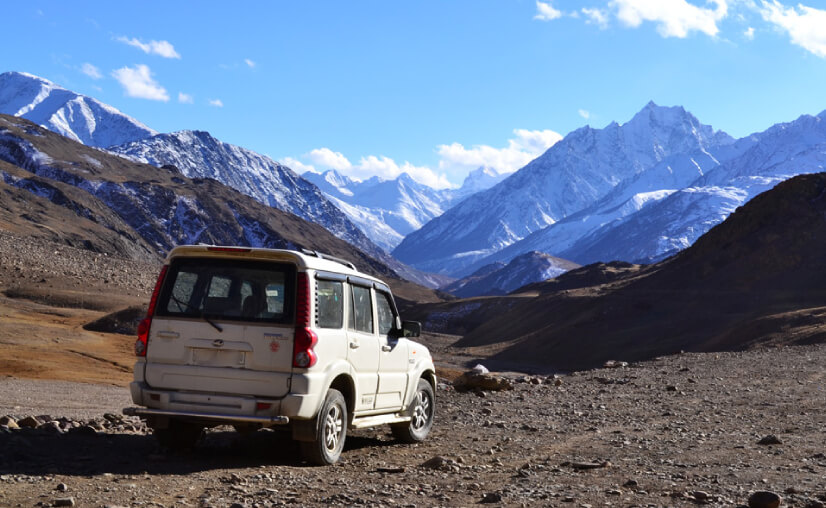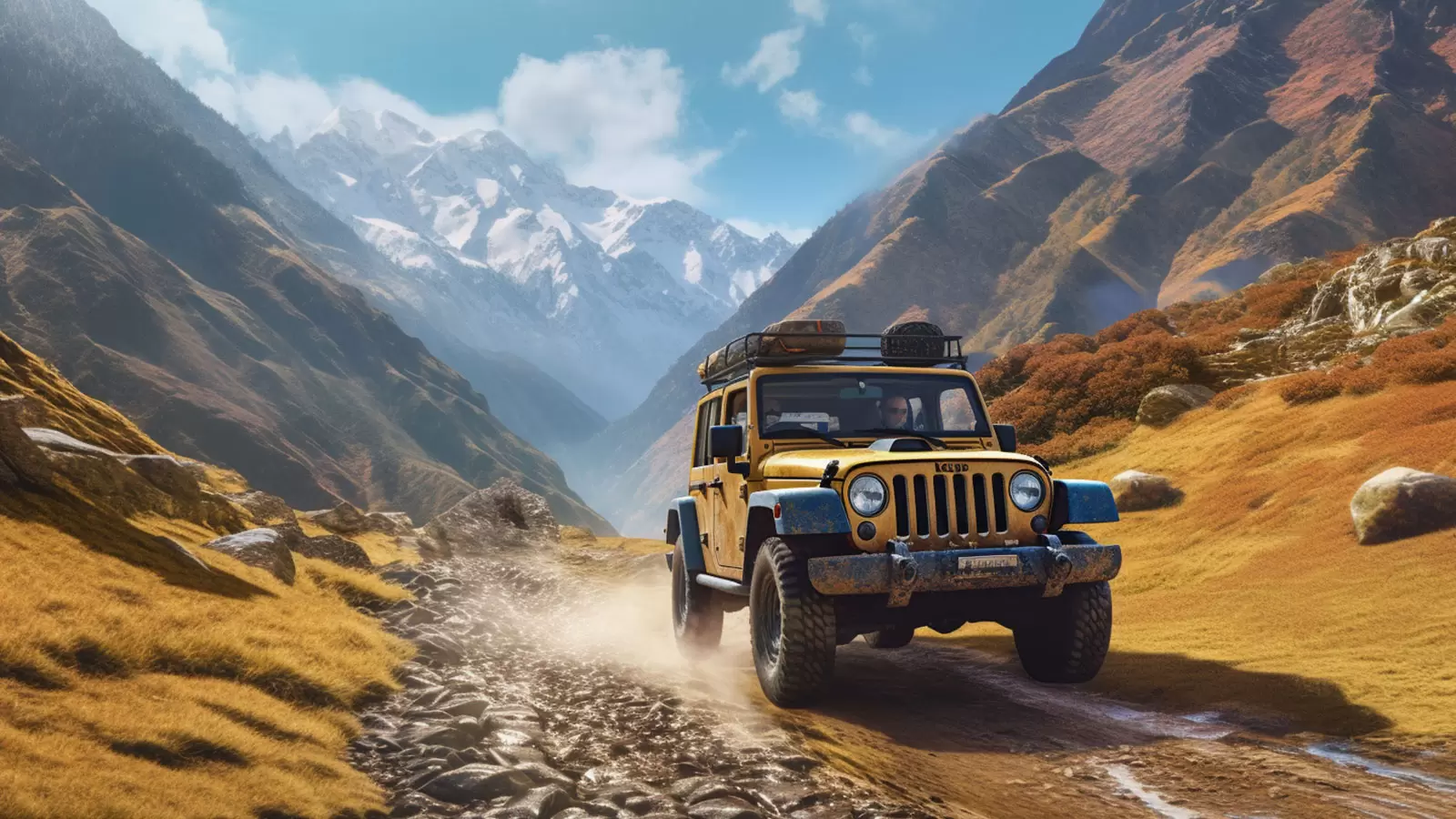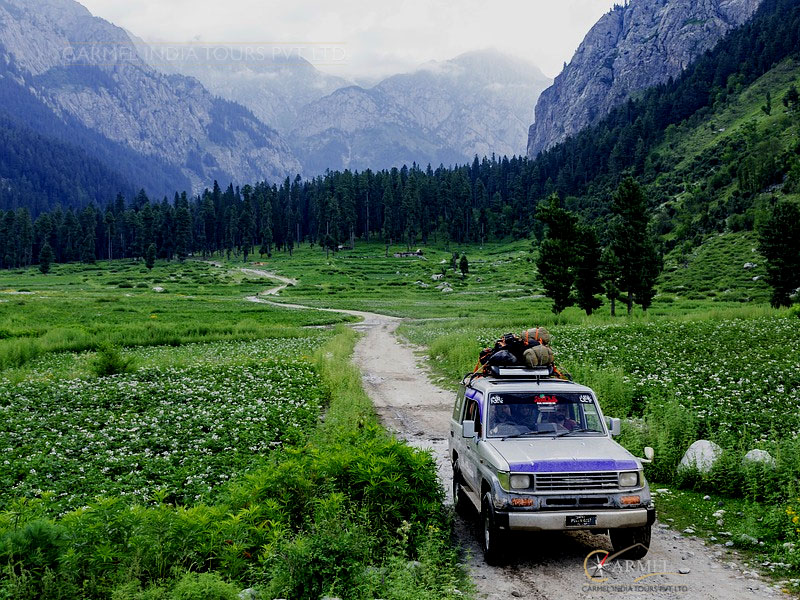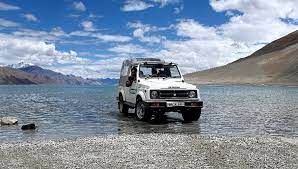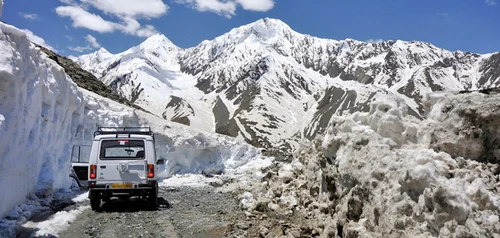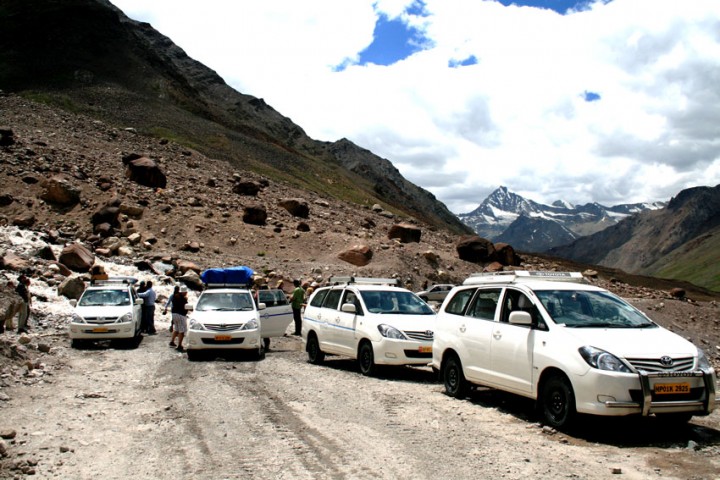Himalayan Jeep Safari – 7 nights / 8 days
Trip Overview
Overview
A Himalayan Jeep Safari in Himachal Pradesh offers a thrilling and adventurous exploration of the majestic Himalayan mountains. It also offers picturesque landscapes, and charming villages of this northern Indian state. This expedition is a perfect blend of adrenaline-pumping experiences and awe-inspiring natural beauty. The journey typically begins in the city of Shimla, the capital of Himachal Pradesh, where adventurers assemble and set off on an exciting road trip aboard sturdy and specially equipped jeeps. The route takes participants through diverse terrains, including rugged mountain trails, dense forests, and serene meadows. As the jeeps traverse the winding roads, passengers are treated to breathtaking views of snow-capped peaks, lush valleys, and gushing rivers. The Himalayan range, with its lofty summits and dramatic landscapes, forms a spectacular backdrop throughout the journey. One of the highlights of the safari is the visit to remote villages nestled in the Himalayas. These villages provide an authentic glimpse into the local culture, traditions, and lifestyle of the mountain people. Travelers have the opportunity to interact with the residents, learn about their customs, and savor traditional Himachali cuisine. The safari often includes stops at significant landmarks and attractions along the way. This could include exploring ancient temples, monasteries, and historic sites that hold cultural and religious importance. The experience is enriched by engaging with the local communities and gaining insights into their centuries-old traditions. The adventure of a Himalayan Jeep Safari isn't only about the destination; it's about the journey itself. The rugged yet captivating roads challenge both the drivers and the adventurers, making every twist and turn an exhilarating experience. The adrenaline rush that comes from navigating through challenging trails is unparalleled. Camping under the starlit Himalayan sky is another memorable aspect of the safari. Participants get to spend nights in cozy tents, surrounded by nature's tranquility. The crisp mountain air, the soothing sounds of the wilderness, and the proximity to the Himalayas create an unforgettable camping experience.Conclusion and Summary
In conclusion, a Himalayan Jeep Safari in Himachal Pradesh is a thrilling expedition that promises adventure, cultural immersion, and unmatched natural beauty. It's an escapade that allows travelers to explore the Himalayas in a unique and exciting way, leaving them with memories that will last a lifetime.Trip Highlight
- Sightseeing tour of Delhi the Capital of India
- Train journey from New Delhi to Kalka
- Ride the UNESCO World Heritage toy train from Kalka to Shimla.
- Sightseeing tour of Heritage parts of Shimla town including the Viceroy’s House.
- Every day – Comfortable Hikes in the Himalayan tribal villages during the tour
- Interaction with the local tribal communities including lunch, tea with them
- Discover the mysteries of the naturally preserved Mummy (15th Century old) of a Buddhist monk at Gue village in Spiti valley.
- Visit to the villages of Chitkul and Gue the last villages on the Indian Tibetan border
- Visit to the World’s highest village “Komic” attached to the road.
- Send a post card to your loved ones from the world’s highest post office at Hikkim.
- Visit Langza village part of the most fossil rich areas in the world by the Geological Survey of India and the Geological Society of America.
- Visit to the oldest and the biggest Buddhist monastery of the Himalayas including Tabo monastery (996 A.D), Key monastery in Spiti valley and Thiksey Monastery in Ladakh.
- Sightseeing tour of Leh town, popularly known as the “Little Tibet”.
- Get closer to glaciers and a number of crystal clear high altitude Himalayan lakes of Nako, Chandra Taal, Suraj Taal and Deepak Taal .
- Cross the five Himalayan mountain passes by jeeps – Kunzum La 4,850 metres, Baralacha La 4,830 metres, Naki La 4,740 metres, Lachalang La 5,019 metres, and Tanglang La 5,358 Metres / 17,582 feet ( the second highest motorable road in the world).
- Visit the traditional Himalayan villages, nomadic camps and meet the local tribal people.
- Take a beautiful flight over the greater Himalayas from Leh to New Delhi.
- Enjoy the Indian and Tibetian Local Food from the Indian Himalayas.
- Explored the best off beat destinations of India in the Himalayas, where you are the curiosity to the locals.
- Chances to see the rare Himalayan wildlife including the Himalayan blue sheep and the snow ibex.
Itinerary
In the morning after early breakfast drive to Shimla by Toyota Innova Car. Lunch enroute. Upon arrival in Shimla, transfer to hotel. Evening free to explore the Mall Road. Dinner and overnight stay at the hotel.
Morning visit Indian Institute of Advanced Studies built in 1888. Situated on a hillock, this was formally the palace of the British Viceroy. Also visit the Jakho temple. Evening visit The Mall the main shopping area of Shimla and The Ridge.
We start our jeep safari to Sarhan Enroute; we visit the palace in Rampur. We drive further the steep mountain and arrive in Sarhan (1950m). Sarhan, the tiny village offers the splendid views of Shrikhanda Mahadev Peak (5155m). You will also visit the famous Bhimkali Temple, the big attraction of Sarhan. Overnight lodge. Sarhan (2125 m): The gorgeous spectacle of the Himalayan ranges with the unspoilt pastoral loveliness of an unpretentious village, Sarahan is truly a haven tucked away in the foothills of the Himalayas. Situated in the Sutlej Valley, on way to district of Kinnaur, Sarahan was the old capital of Rampur Bushair, one of the biggest princely states in Shimla hills. The major attraction in Sarahan is centuries-old Bhimkali Temple and Raja Bushair Palace. Steeped in legend, the temple complex is a resplendent example of hill architecture. Sarahan is also the gateway to Kinnaur.
Drive along the spectacular Hindustan Tibet road which s carved in a rock and goes along the wild Sutlej River. A view of Kinner – Kailash Peak is splendid from Sangla. Visit remote villages of Rackcham and Chitkul. On arrival in Sangla check in and overnight at camp. Sangla Valley: This valley starts 57 kms. Short of Kalpa which has been named after a beautiful & populous village Sangla. Sangla is situated on the right bank of Baspa river 17 kms from Karcham. Journey from Karcham onwards is enjoyable and adventurous throughout the valley. The natural scenery all around and the eternal snow view are picturesque and charming. It is also known as Baspa Valley since Baspa River flows through this area. This is the most charming valley in the entire District of Kinnaur. A temple dedicated to Nages god is worth a visit & other places are Sapni, Rackchham, Kilba, Kamru Fort which can also be visited. There are post offices, banks, rest houses for the convenience of the visitors.
Morning visit Kamru village and fort. Later travel by surface from Sangla to Kalpa located in backdrop of Kinner Kailash mountain range. Evening free to explore Kalpa village. Kalpa (2759 m): Beyond Recong Peo (14 kms. from Powari) on the link road, is the main village of the District – Kalpa. Across the river, facing Kalpa is the majesty of the Kinner Kailash range. This is a spectacular sight early in the morning as the rising sun touches the snowy peaks with crimson and gold light.
Travel by surface from Kalpa to Tabo enroute visiting Nako village beautifully located on banks of a small lake. On arrival in Tabo check in and overnight at guest house. Tabo Monastery: It is another big gompa for serving the population of eastern side. It belongs to the tenth century and is located 50 kms from Kaza. It is a famous gompa next to Tholing Gompa in Tibet. It has about 60 Lamas and a large collection of Scriptures, wall paintings etc. Murals of this gompa have a great similarity to that of the Ajanta paintings.
Morning visit Tabo monastery. Later travel to Kaza enroute visiting Lalung and Dhankar Gompa. On arrival in Kaza check in at guest house. Dhankar Monastery: It is situated about 25 kms. East of Kaza and serves eastern part of central Spiti. Dhankar is a big village and erstwhile capital of Spiti Kingdom. On top of a hill there is a fort which uses to be the prison in olden times. The Monastery has about 100 Lamas and is in position of Budhist scriptures in Bhoti language. Principal figure is a Statue of “Vairochana” (Dhayan Budha) consisting of 4 complete figures seated back to back. It has relics in the shape of paintings and sculptures.
Morning visit the Ki monastery, 12 kms from Kaza. This centuries old gompa is a labyrinth of rooms and corridors – and at one time also acted as a fort. It houses valuable Thangkas and offers a panoramic view of the area. Also visit the small gompa at Kibber, 9 kms further ahead. Kibber at 4205 m/13,792 ft has the distinction of being the highest permanently inhabited village of the region. Ki Monastery: It is situated 12 kms north of Kaza and serves the western population of Spiti. It is the oldest and biggest monastery of the valley and located at (4116 m) above Ki village. It houses beautiful scriptures and paintings of Budha and other goddesses. Lamas practice dance, sing and play on pipes and horns. Many Lamas get religious training here. It has murals and books of high aesthetic value. Kibber (4205 m): It is locally known as Khyipur, one of the highest villages in the world at an altitude of 4205 m above sea level in a narrow valley surrounded by mountains from all sides. Rest Houses available for the visitors. Gette village, at a short distance away from Kaza, is the highest in the world with a height of 4270 m.
In the morning drive to Keylong via Kunzam Pass (4558 m/14,950ft) which provides beautiful views of CB ranges. Enroute visit several villages of Spiti and Lahaul valley. On arrival check in at hotel. Dinner and overnight stay at the hotel. Keylong (3340 m): Keylong is the district Headquarters of Lahaul Spiti on the main road to Leh over Rohtang. It is an oasis of green fields and willow trees, water streams surrounded with brown hills and snow capped peaks.
Today we will drive from Keylong to Sarchu over Baralachala Pass (4800 m). On arrival check in at camp at Sarchu. Evening free to walk around in Sarchu. Dinner and overnight in camp. Sarchu: It is the last border point between Himachal and Ladakh, where HPTDC put up a tented colony for the convenience of the tourists during summer season. It is situated at a distance of 116 kms.
Early morning drive to Leh gives you a feeling of being in the high Tibetan Plateau. One climbs a series of Galta loops consisting of 32 hairpin bends on the way up from Sarchu and come out in Pang valley. It is here that one can divert to the right and visit the huge high altitude lakes of Tsokar and Tsemoriri. This region also has rare wild life like the Tibetan wild Ass, wolf, and the elusive Snow Leopard, the black-necked Crane and Tibetan Snow Cock. Cross to the other side of the Pang, Tzanspo River to continue drive up to yet another plateau for a long traverse on the legendary Moore plains. The highest of the Tibetan Plateau at 4200 Mts. Continue driving Tangling La (5280 Mts.) the second highest motorable pass in the world that commands breath taking views of the Zanskar range. A pleasant drive about 20 Kms brings you to the Ladakhi hamlet, Gya, heralded by prayer flags. After crossing few more villages one reaches the great Indus River. Further drive to Leh town, overnight at hotel. Leh: Leh is the fascinating capital of the Autonomous Hill Council of Ladakh, also known as Little Tibet. The important monasteries to visit in and around Leh are Shey, Thiksey, Hemis, Spituk, Samkhar as well as the Shanti Stupa, Stok Palace and main Bazaar. The Leh palace dominating the town was the former home of the Namgyal Dynasty. The monastic festivals are very popular and Hemis, Phyang and Lamayuru festivals in summer are visited by lot of tourists who throng to see the Cham Dances.
After breakfast full day sight seeing. Evening back to hotel for dinner and overnight stay. Shey Gompa is about 15 kms from Leh. It used to be the summer palace of the kings of Ladakh. There are lots of Stupas and Gompas built around the palace. Shey palace was built by Deldan Namgyal in the beginning of 17Th century AD. Main attraction in Shey is the 12m Shakyamuni Buddha statue inside the Dresthang Gompa. Thiksey Gompa, close to Shey is about 17 kms from Leh. The monastery is considered to be one of the most beautiful in Ladakh and belongs to the Gelukspa order. Hemis, about 45 kms south of Leh it is one of the most famous and largest monastery in Ladakh. It belongs to the Drukpa order and was founded in the early 17Th century. The setting is perfect with the monastery cradled in a lovely valley, surrounded by streams and fronted by long Mani walls.
(Leh local sight seeing) In the morning we will visit some other places. Evening back to hotel for dinner and overnight stay. Leh Palace: The palace is a distinguished monument and a historical building. The nine- storied palace was built by the 17th century illustrious ruler of Ladakh Sengge Namgyal. Jama Masjid: The historical mosque is situated in the heart of Leh town. It was built in 1666-67 A.D.consequent to an agreement between the Mughal Emperor Aurangzeb and then ruler of Ladakh,Deldan Namgyal. Spituk: The gompa stands prominently on the top of a hillock, 8 Kms.from Leh, and commands a panoramic view of the Indus Valley for miles. Many icons of Buddha and five thankas are found in 15th century monastery. There is also a collection of ancient masks, antique arms and an awe inspiring image of Mahakal. Phyang: The monastery is situated 17 Kms. from Leh on the Leh – Kargil road. It was built by Tashi Namgyal in the later half of the 16th century A.D. and looks like a place from a distance. The gompa belongs to the Red Cap sect of the Buddhists. Hundreds of icons of Buddha are kept on wooden shelves .
In the morning drive for the Khardung – La Pass. This is the ultimate challenge of the trip. It is the highest motorable road in the world taking you to a dizzy 5,600m! The view from the top is spectacular, stretching from the Indus valley in the South over the endless peaks and ridges of the Zanskar range to the giants of the Sesser Massif in the North. You can feel proud of a true achievement as you finish the trip with your final satisfying descent. Evening back to Leh for dinner and overnight stay.
In the morning take a flight for Delhi. Upon arrival at Delhi drive for local sight seeing. Evening transfer to international airport.
Departures & Availability
The set departure dates listed are specially quoted and specified for group joining option. Let us know if the set departure dates are not suitable for you- another dates which are suitable for you can certainly be added by us.
Check Available Dates
| Start Date | Price | Availability |
|---|
All trip prices are per person based on double occupancy, are subject to change without notice and do not include airfare. All prices and fares are quoted in U.S. dollars.
Price include
- All accommodation on twin sharing using hotels with modern amenities or as per your choice.
- All transportation, using 1 Air conditioned SUV car including all sightseeing as per the tour details, fuel, toll taxes, parking, state taxes.
- Meals Including Breakfast and Dinner during the entire tour.
- English Speaking Escorted Guide for entire tour.
- Shatabdi Express Train tickets in Executive Class (1st Class) from New Delhi to Kalka.
- 1st Class Train Tickets for the Kalka Shimla Mountain Railways the toy train
- All kind of Entrance tickets to visit monuments, temples, museums etc. wherever required during the entire tour as per the tour itinerary.
- Inner line permits fees to visit the restricted areas of Kinnaur, Spiti valley.
- 1 lunch with the local tribal people in Langza village, local house
- Internal domestic flight from Leh to New Delhi back at the end of the tour including baggage allowance of 25 Kgs + 7 kgs hand baggage per person.
- 1 bottle of mineral water per person, per day
- All airport arrival and departures
- Assistance on arrival and departure.
- All kind of hotel taxes and 5% GST
Price Excludes
- Any kind of lunch during the tour
- Any kind of flights / Train tickets/ local guide.
- Any kind of tips to drivers/hotel staff.
- Any kind of alcohol drinks ( Beer/ wine etc).
- Any kind of camera fees.
- Any kind of entrance tickets to monuments/ museum/ parks
- Any kind of room heater in hotels.
- Any kind of entrance tickets to monuments/ museum/ parks
- Any kind of adventure activity skiing, paragliding, pony rides, rafting etc.
- Any change in the tour management / additional arrangement due to road blockage or sudden change in tour plan by you / flight cancellations/ flight missed or things beyond our control etc.
- Any Kind of Personal Expenses or things which are not mentioned In the “Cost Includes”.
- Please Note: Kindly contact the hotel reception directly, in case you need a room heater and any extra cost to use the room heater had to be paid directly by you, which is charged for per night basis by the hotelier.
- A/c in the car will not work in the hill area of Himachal Pradesh; it will be available in the plains during the rest of journey. In case you need full A/c service in the car during the tour, It is going to cost you extra and you need to discuss it with us while planning your holiday tour with us.
Gears And Equipment
Trip Information
Jeep safari in Indian Himalayas – an Introduction!
According to many people, mountains are only meant for adventure activities like mountaineering, trekking and mountain biking. Well! that is actually a misconception. Mountains also offer great opportunities for jeep safari tours that in fact, are a unique way to explore the serene mountain beauty sitting in comforts of your jeeps and rediscovering the charms of high mountainous roads. Blessed with diverse hilly landscapes and varied topographies, India is gradually becoming a favourite destination for adventure aficionados who love to explore mountain beauty sitting in their 4X4 vehicles, witnessing unmatched scenic vistas simultaneously, braving the challenges of rugged terrains and craggy roads. A jeep safari expedition in India can be best experienced in Himalayan regions of Ladakh, Garhwal, Kumaon and Himachal.
Taking you through high Himalayan roads, a jeep safari offers you mesmerizing vistas of snow-draped Himalayan peaks and ample opportunities to bedazzled with the azure beauty of high altitude lakes. Well! that is not all, on a jeep safari, you can also experience a melange of cultures, soak your souls in deep spirituality and witness an endemic Himalayan wildlife.
Popular jeep safari destinations in the Indian Himalayas Region:
Ladakh : The most popular and inarguably, the favourite jeep safari destination in India is the mystical land of Ladakh. The Manali-Leh tour in the region is the most popular amongst adventure enthusiasts and offers you ample opportunities to witness a dramatic shift in the landscape that changes from lush green pastures of Manali to parched and arid terrain of Lahaul valley in Ladakh. Known as the land of high passes, Ladakh Jeep Safari also provides you with unmatched thrills of crossing some of the world’s highest mountain passes and overcoming the challenges of harsh and unpredictable weather conditions. On a jeep safari expedition in Ladakh, you also get ample opportunities to feast your eyes with hypnotic beauty of its picturesque Tso Moriri and Pangong Tso lakes known for their picture postcard perfect beauty. Sitting in deep wilderness of serrated mountains, a tour of these lakes, will at once, make you fall in love with this beautiful region dotted with impeccable beauty. Soaked in deep Buddhist culture, Ladakh Safari trip also allows you to have a glimpse at its enticing monasteries. Perched atop hills and sitting amidst tranquil locations, a tour of these monasteries is sure to fill your hearts with deep peace and solitude.
Uttarakhand: Known as the land of Gods, Uttarakhand sits amidst beautiful peaks of Garhwal Himalayas and provides for some of the most adventurous and exhilarating jeep safari holidays in India. Adding a spiritual touch to your adventurous expedition, a safari holiday in Uttarakhand takes you through the pious land of Rishikesh where you can also indulge yourselves in the fun of water rafting. Further, traversing through the regions of Barkot, Yamunotri, Harsil, Gangotri, Auli and Uttarkashi; a jeep safari tour through Uttarakhand not only offers you opportunities to pay your homage in sacred ‘Char Dhams’ but, also provides you with unmatched spectacles of scenic landscapes that fill your hearts with joy, freshness and spirituality.
For wildlife enthusiasts, a jeep safari tour through the regions of Binsar, Munsyari and finally ending in the Corbett National Park, is an experience to die for. Offering you mesmerizing vistas of snow-covered peaks of Trishul, Chaukhamba, Nanda Devi and Kedarnath, unfolding spellbinding beauty of numerous waterfalls and last but not the least, presenting you with the exhilaration and excitement of spotting an elusive tiger hidden in thick grasslands of the Corbett reserve; a jeep safari tour in Uttarakhand is a perfect choice for those who crave for adventures and thrills.
Himachal Pradesh: A jeep safari tour in Himachal Pradesh is an ideal way to explore the impeccable beauty hidden in serene and enchanting valleys of the region. From sight-seeing in Dharamshala to scenic exploration of Manali; a jeep safari tour in Himachal also offers you plenty of opportunities to witness a blend of different cultures and lifestyles that prevail in the region’s ethnic villages and quaint hamlets. On a jeep safari tour in Himachal, you can also uncover the unspoilt beauty of some its remote and serene valleys including Kinnaur and Spiti that lie hidden in extreme wilderness of Western Himalayan ranges.
Best time for jeep safari in India
The best season and time for embarking on a jeep safari tour in Indian Himalayas depends on the region you wish to explore. Ideally, the best time for jeep safari in Ladakh is between the months of May and September when the weather is salubrious and rejuvenating. For a jeep safari tour in Himachal and Uttarakhand, the best time is during the months of May and October, except the monsoon months in between.
Why embark on a jeep safari tour with us?
We offer exclusive deals and packages for jeep safari tours in Himalayas. With an experience of more than three decades in the travel industry and with a team of experienced staff, we make sure that our jeep safari holiday packages are specially designed as per your needs and requirements.
A jeep safari vacation in the Himalayan region requires great expertise and knowledge that can help you overcome unseen challenges while driving through remote and secluded areas. With us, you are in safe hands as we ensure that your safari tour is led by an expert and knowledgeable local guide who has deep understanding of the landscapes and terrains of the region.
We also help you have cherishable memories of diverse cultural encounters by assisting you have interactions with local people and understand their ways of living. Arrangements for sight-seeing and shopping are few of our other services that you can rely on us for.
Having associated with us, you can also be ensured of being provided with best of the services including accommodations, transportations and hotel transfers. We have a trusted name in the industry and with us, you are sure to have the most enriching and memorable experiences on your jeep safari adventure holiday.
Himalayan Jeep Safari Tour Route Map
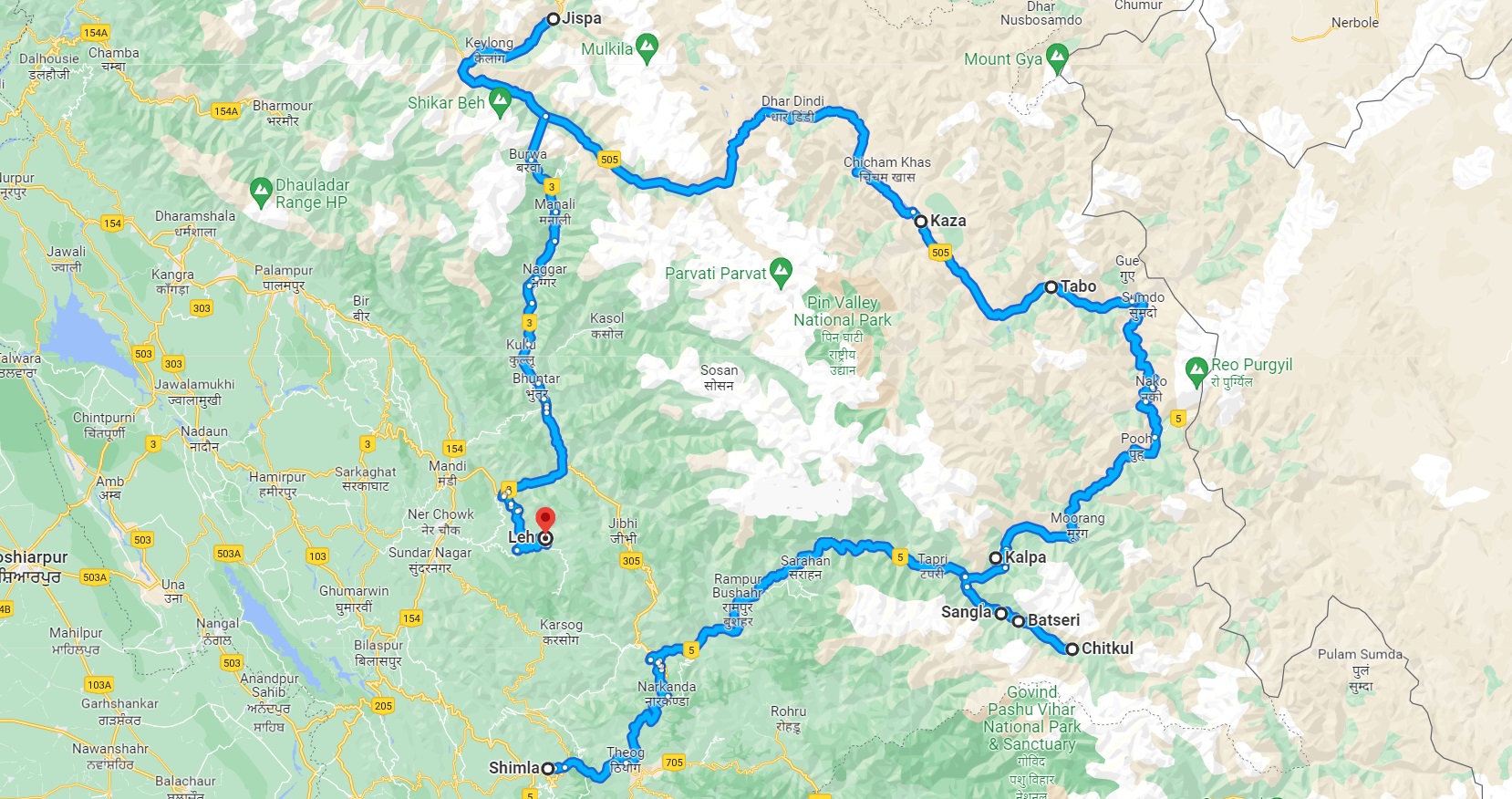
FAQS
Lorem Ipsum is simply dummy text of the printing and typesetting industry. Lorem Ipsum has been the industry’s standard dummy text ever since the 1500s, when an unknown printer took a galley of type and scrambled it to make a type specimen book. It has survived not only five centuries, but also the leap into electronic typesetting, remaining essentially unchanged. It was popularised in the 1960s with the release of Letraset sheets containing Lorem Ipsum passages, and more recently with desktop publishing software like Aldus PageMaker including versions of Lorem Ipsum.
Lorem Ipsum is simply dummy text of the printing and typesetting industry. Lorem Ipsum has been the industry’s standard dummy text ever since the 1500s, when an unknown printer took a galley of type and scrambled it to make a type specimen book. It has survived not only five centuries, but also the leap into electronic typesetting, remaining essentially unchanged. It was popularised in the 1960s with the release of Letraset sheets containing Lorem Ipsum passages, and more recently with desktop publishing software like Aldus PageMaker including versions of Lorem Ipsum.
Traveler Reviews
These full and frank reviews are from travelers who have traveled with Ace the Himalaya previously. The reviews and experiences shown here are from reputable travel websites like TripAdvisor, Google, Facebook, and Trust Pilot, etc.

